Performing forearm training with a backpack might not seem easy or convenient. However, you’d be surprised at the forearm size that you can attain with some imagination and a little determination.
This guide will cover various forearm calisthenics and dynamic exercises to really create that robust hypertrophy that we’re all looking for.
Related workouts: shoulder and forearm exercises │bicep and forearm workout routines
Is using a backpack enough for the forearms?
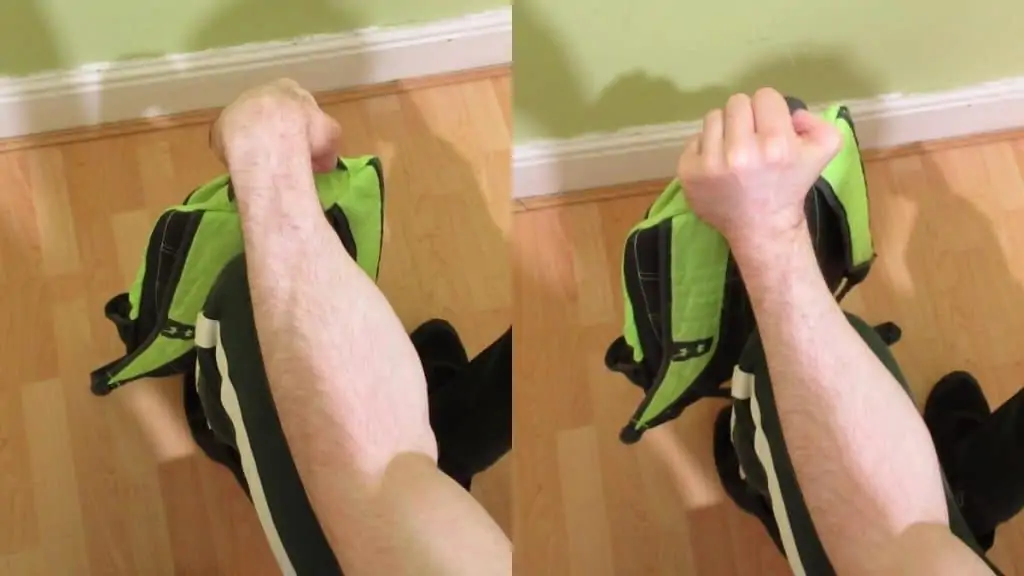
What is a backpack?
Sure, it’s something that you wear on your back to transport personal goods and possessions. But what is a rucksack to your muscles?
Tension. That’s what.
Like a dumbbell or barbell exerts force on the forearm muscle fibers, so too does a backpack.
We can use this simple fact to our advantage by filling our bag with household objects (more on that in a sec) to get the right amount of resistance for our strength level.
Ultimately, if you use good form and lift with enough resistance, you can build just as much muscle by training with a rucksack as you can while lifting free weights.
Heck, even just wearing a backpack can challenge the muscular system. [1]
Of course, lifting free weights is a bit more convenient than filling up a backpack, but the difference isn’t huge. This is especially true because we’re training at home. So, in other words, we won’t be wasting any time commuting to and from the gym (or waiting for machines).
What can you put in your backpack for resistance?
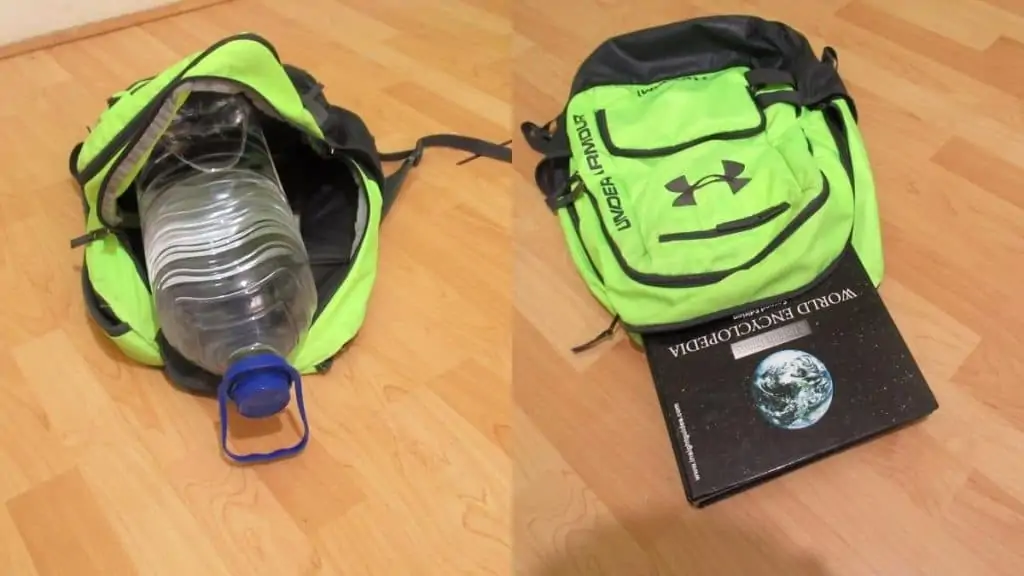
This depends on the specific exercise that you’re doing. But in general, if you want to adjust the resistance, you simply use less of whatever weighted object you have available.
Books are my first choice. You can pack them flat or lengthways, and they easily stack next to and on top of each other. So in this regard, they’re probably the most convenient method for getting some serious rucksack resistance.
But if you’re not a fan of reading books, then you can also fill up some water bottles and place them in your bag. Like books, this weighting method offers plenty of resistance that’s easy to adjust because you can simply remove a couple of bottles to lighten the weight (or just pour out some water).
Alternatively, use groceries like rice and oats for resistance. This method will make the bag softer, which is good if you’re wearing it on your back. However, you won’t get quite as much resistance as with books or liquid.
The final option is sand. You could take an old bag and fill it with sand if you don’t mind it getting dirty. The upside of this is that you can get very high levels of resistance. The downside, of course, is that you’re going to make a mess. So this method is best reserved for those who train outside.
Forearm exercises that you can do with a backpack
When you’re doing a forearms workout backpack style, it’s important to consider the specific exercises to base your routine around. This is because the lower arms consist of tons of small muscles that each require different movement patterns (flexion vs extension vs pinching) for optimal development.
Backpack wrist curl
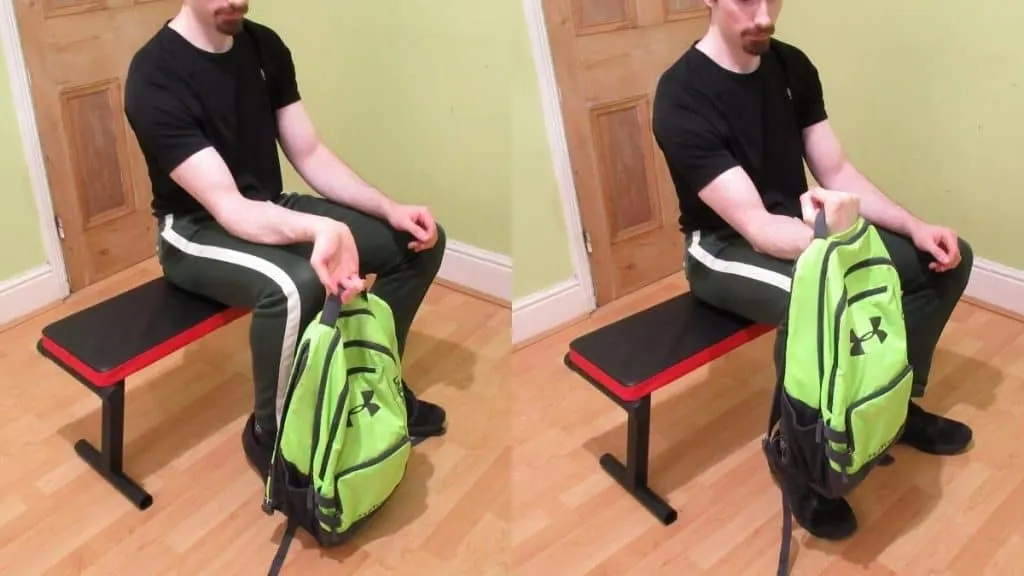
Once you’ve filled your backpack, you’ll want to sit down and hold the “hook” part of the bag, which is to say the fabric that you’d place on a peg to hang the backpack.
From there, place your lower arm, palm up, on your thigh. The hook part of the bag should be in the palm of your hand. Then, slowly lower the bag towards the ground by bending your wrist. Descend until you feel a good stretch and then curl the rucksack back up by flexing your forearm. Repeat for 2-3 sets 10-12 reps.
If your bag is particularly large, however, then you might find that it hits the floor before you get a full stretch. If this is the case for you, then you can simply perform the exercise while standing. The form is exactly the same. You just flex your wrist, and by that, I mean move your hand closer to the underside of your forearm.
Backpack reverse wrist curl
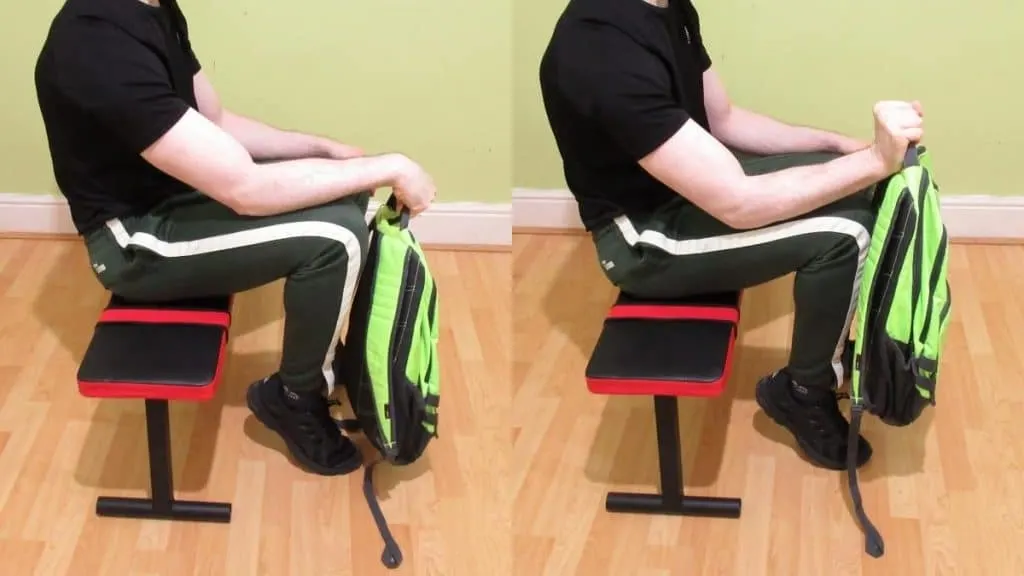
This drill requires less weight than the regular wrist curls because the forearm extensors are a weaker muscle group than the flexors.
Since we’re using relatively light loads here, the exercise is pretty easy to set up, which means that you can actually do this movement by hanging your hand off the edge of a desk or table.
From there, you once again want to lower the bag towards the floor by bending your wrist until you feel a nice forearm stretch. Then, extend your wrist towards the sky until your hand goes past where it would be level with your forearm.
Stick to higher reps for this one because the extensors are very slow twitch. 2-3 sets of 15-30 reps will do the job nicely.
See also: kettlebell forearm workout │forearm exercises for women
Rucksack pinches
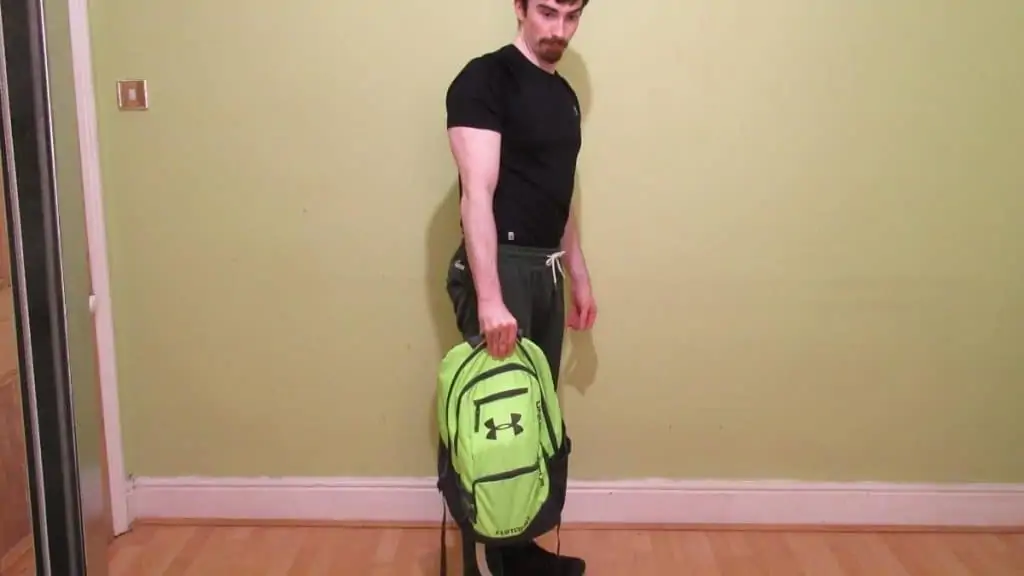
Many bodybuilders erroneously stop at flexion and extension for their forearms. And while these two exercise types can still lead to impressive development, it’s one of the worst ways to strengthen your grip.
Pinching, on the other hand, will activate forearm muscles that you didn’t even realize existed for you. Besides building up the forearms themselves, pinching drills improve your overall grip strength.
Essentially, you want to fill the backpack with moderate to heavy weight. Then, grip one of the straps between your fingers and thumb, and hold this position for 15-30 seconds.
If the strap is too thin to grip, then you can hold the backpack (again between your fingers and thumb) in a different area. The beauty of backpack training is that it’s versatile. It doesn’t matter where you grip the bag as long as you feel it in your forearms.
Forearm iso holds
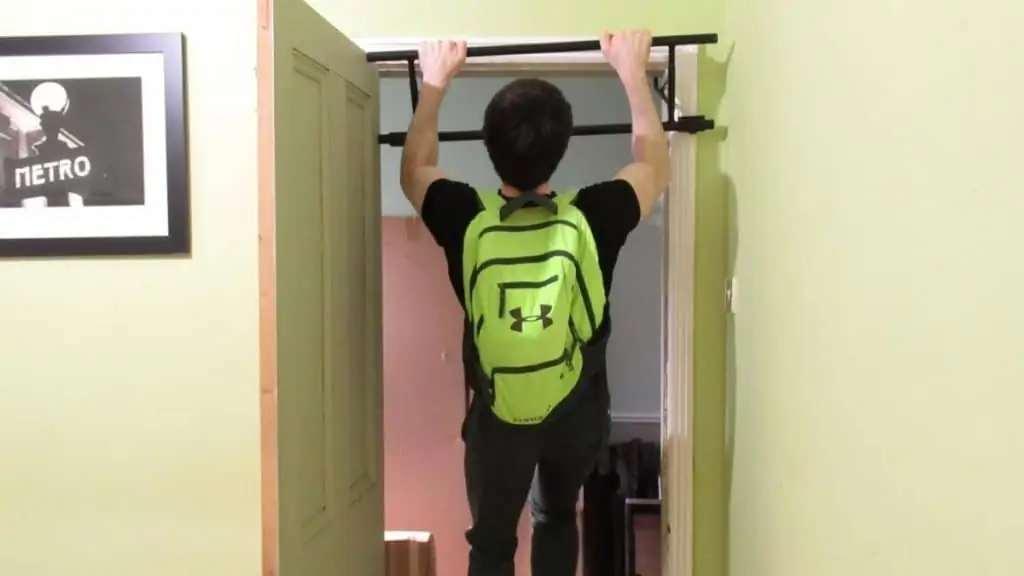
This exercise usually requires a pull up bar (don’t worry, they’re pretty cheap). However, you can do it on any sturdy object like metal equipment at the park, soccer goals, or even a sturdy tree branch.
Fill the backpack with moderate weight and then grip the bar with a shoulder-width overhand grip. Try to use the palms of your hands to hold on rather than your fingers initially. As you tire, your fingers will naturally take the strain, but we want our forearms to do the bulk of the work early on.
Try and hold on for 30-60 seconds initially.
Alternatively, try the exercise without a backpack, especially if you’re carrying excess body fat. After all, holding your body weight with your forearms for a minute straight (especially after a full workout) is hard enough. Using a backpack for extra resistance is definitely an advanced training technique that you should work up to.
And yes, this drill has awesome carryover to your chin-ups and pull-ups.
Read more: forearm dumbbell workout │forearm exercises at home
Forearm backpack workouts
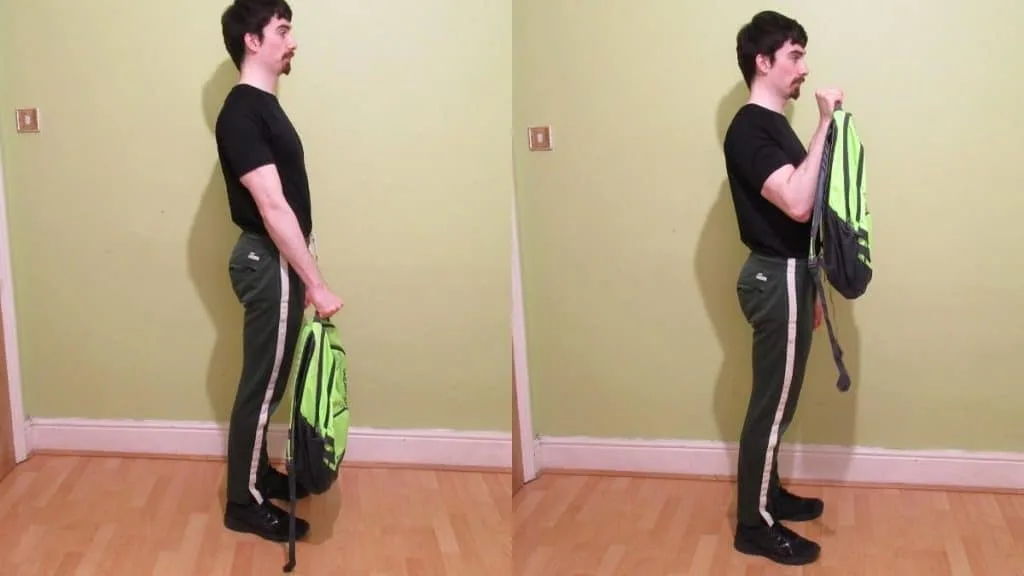
Again, when we’re performing forearm workouts with a backpack, we need to be very deliberate about the exercises that we perform if we want to stimulate all parts of our lower arms.
For example, many people forget about reverse curls, which are fantastic for building the brachioradialis.
Beginner workout
1: Backpack wrist curl — 2 x 10-12 reps
2: Backpack reverse wrist curl — 2 x 15-20 reps
3: Backpack reverse bicep curl — 3 x 8-12 reps
4: Backpack pinch — 2 x 30 second holds (per arm)
Advanced workout
A and B indicated a superset pairing.
1A: Backpack wrist curl — 3 x 12-15 reps
1B: Reverse backpack wrist curl — 3 x 15-20 reps
2: Reverse backpack bicep curl — 4 x 8-12 reps
4: Backpack pinches — 3 x 30 second pinches (per arm)
5: Pull up bar holds — 2 sets to failure
Read more: resistance band forearm workout │bicep tricep forearm workout
Conclusion: Are forearm backpack workouts worth your time?

Although health clubs have their place, many of us go to the gym and then realize that we’re better off training at home. [2] We end up saving a bunch of time and don’t have meatheads giving us questionable training advice. Plus, who doesn’t like saving a few quid on monthly memberships?
As for the forearms, working out with a backpack is not only viable; it’s an excellent way to train because it requires no additional weights. Plus, you can do these exercises anywhere, even if you’re on the road.
I recommend starting with the beginner forearm backpack workout to acquaint yourself with the movements. Then, keep doing the workout for a few months until you’ve milked the initial gains.
Then feel free to move onto the advanced routine (or even make your own), where your forearms will benefit from the supersets and the extra training volume.
References
- Perrone, M., Orr, R., Hing, W., Milne, N., & Pope, R. (2018). The Impact of Backpack Loads on School Children: A Critical Narrative Review. International Journal of Environmental Research and Public Health, 15(11), 2529. https://doi.org/10.3390/ijerph15112529
- Schroeder, E. C., Welk, G. J., Franke, W. D., & Lee, D.-. (2017). Associations of Health Club Membership with Physical Activity and Cardiovascular Health. PLOS ONE, 12(1), e0170471. https://doi.org/10.1371/journal.pone.0170471

